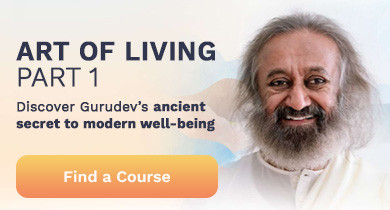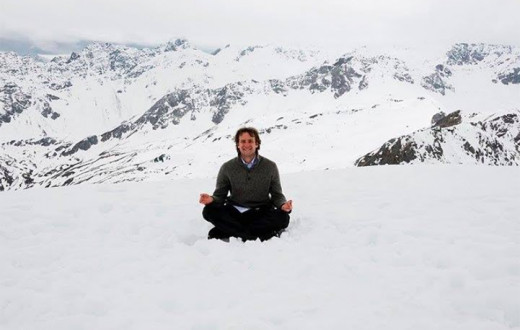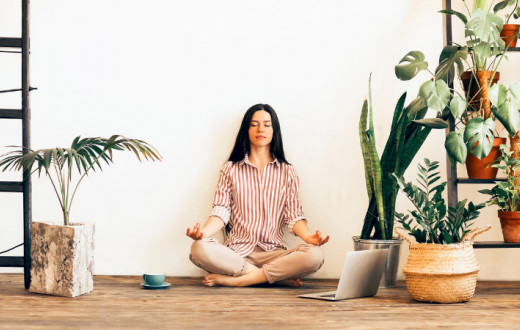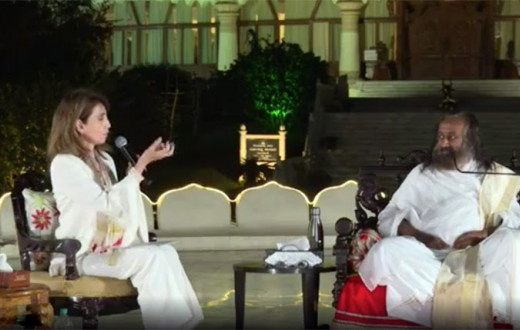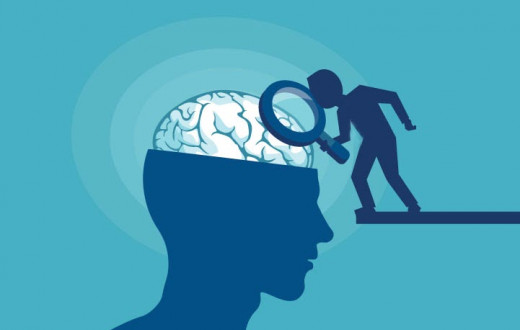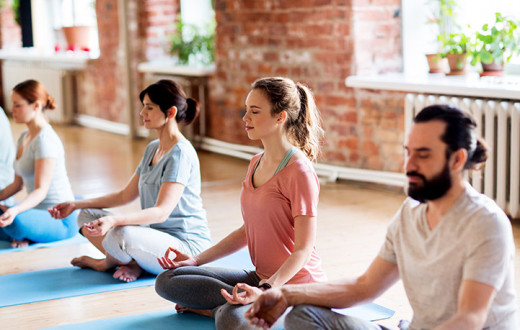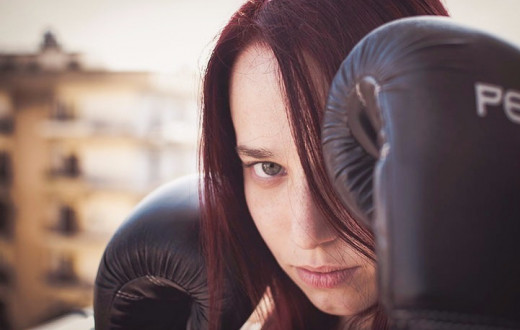By Elizabeth Herman┃Posted on : December 03, 2020
For your meditation to be deep, your posture should be comfortable. Use these 11 tips to find a correct posture to meditate and relax.
The number of Americans who say they meditate weekly is 40% of the U.S. population. All over the world, between 200 and 500 million people meditate. If you've tried meditation, good for you!
But what posture is the best one when you meditate? The answer can depend on your needs.
Meditation posture has both physical and mental aspects. It's important that it fits well into your unique circumstances. As your body and mind change, your meditation posture changes as well.
You can look at a variety of options and procedures available. Here's a look at what meditation posture is, how it works, and your choices.
What is meditation posture?
For most meditations, a good physical posture for meditation feels relaxed yet upright. An erect spine reminds you that meditation isn't the same as sleep. Feeling comfortable and loose reminds you that meditation is effortless.
You want to avoid stiffness and laziness. The close relationship between body and mind will play a part in the quality of your experience. During meditation, you'll be happier if you attend to your posture.
A mental posture for meditation involves commitment and respect for the practice. You commit to meditating for the full allotted amount of time. You also commit to meditating daily for an ongoing routine of mental hygiene.
Like finding time for regular exercise and bathing, you schedule the time to meditate. You honor yourself and your intentions by sticking to that schedule.
Why is posture important in meditation?
Here are 4 reasons why it's important to find the right meditation posture:
Let go of effort: You can't completely leave your body, even though deep meditation can make you feel that way. Experts know that physical effort has positive effects. But mental effort has negative results during meditation. Meditation is effortless. It allows the mind to renew itself. As the body needs exercise to revive its energy, the mind needs to stop trying to relax.
Avoid sleep: The pose that keeps the mind still is a good meditation posture. But if you’re too relaxed, sleep might come. By sitting up for meditation, you can feel that you’re there for more than sleep. The difference between sleep and meditation becomes clear. Your physical posture helps you recognize that.
Stop distractions: Have you noticed discomfort distract your mind? Physical comfort helps to reduce any distractions. That's why you need to take time to find your most comfortable posture for meditation.
Set intentions: Do you ever use your body to firm up your resolve? The meditation position can help you set an intention to stay with a meditation practice for the allotted time. Once you get into a posture, you can commit to staying there until you finish.
What are the different types of meditation postures?
The most popular meditation postures are simple sitting poses from yoga. Here are 3 examples:
Sukhasana (Cross-legged position)
Sit with crossed legs. Hold the elbows a little bit inward toward the torso. Your palms should face the sky. Rest the backs of your hands on your knees. Keep your head straight and spine vertical.
"Sukha" is Sanskrit for comfort or happiness. Remember to smile. If you can't cross your legs, you can use a chair. If you prefer, resting your back against a wall is an option.
Lotus pose, the most famous and popular one to ancient yogis for meditating, could become your favorite too with reasonable practice. It keeps your spine erect without extra effort.
Sit with your legs extended in front of you. Stretch them out. Feel the energy in your toes, feet, and leg joints. Bend your right knee and place your right foot on the base of your left thigh. Now bend your left knee and place your left foot on the right thigh. Your heels can point upward.
Your hands can rest on your knees with palms facing up. Relax the upper body (shoulders, neck, etc.). Your spine stays erect without much effort. Your head stays straight.
This can be a difficult posture for a beginner or even for an advanced meditator. If it is for you too, listen to your body. Don’t force yourself into this pose. It can harm your knees if you don’t do it in the correct way. Instead, choose to meditate in sukhasana or any other posture that you feel comfortable with as long as you are able to keep your spine erect yet soft.
The above two are the ideal postures for meditation, but some people are also comfortable with meditation in Vajrasana.
Kneel down with your knees touching. Your feet provide a cavity to sit on. Don't sit on top of your heels. Place your hands on your thighs, palms facing upwards. Keep your spine erect and head straight.
If you need to, roll up a towel or place a thin pillow under your ankles for support.
This pose helps improve digestion. It also strengthens your thighs and calves.
Some other postures for specific mediation techniques:
As mentioned above, seated postures are the best way to meditate. But some specific meditation techniques use other postures as well.
Yoga nidra, a meditative and relaxing technique, can be practiced either seated or lying down in Corpse pose.
Walking meditation: As the name suggests, in this technique you mindfully walk. Stay at a gentle pace and maintain awareness of your breathing with each step.
Which posture should I use for meditation?
The following 11 tips can help you find the correct posture for your own meditation experiences:
Relax and don’t sleep. Practice this state of mind often.
Explore different meditation postures. Most meditation occurs in a sitting position. But a variety of other postures (standing meditation, walking meditation) exist.
Have an attitude of commitment to complete your practice. Your mental respect is as important as your physical pose.
You might have back pain at times while sitting in meditation. Each experience is different for each person. Your comfort level depends on the times you're going through and many other factors.
Don’t judge your body if you have pain. Pain signals the need for a more comfortable position. As you work with physical posture, listen to those messages. Honor and respect how your body communicates with you.
Use a backrest if you need one. Meditation classes will often provide back support props. Take a back jack on the floor, a chair, a meditation bench, a wall to lean on, a meditation cushion, or any other method as needed.
Be patient with yourself as you learn to sit up for a full meditation session without a backrest. It may take time.
Sample different meditation postures. Take time to find out which is most comfortable for you.
Start a practice of yoga postures with a teacher who can help you find the best posture.
If you sit in a chair, try to sit forward without slouching. Don’t use the backrest for every sitting meditation.
Check these seven points: how you’re sitting, your spine, hands, shoulders, chin, jaw, and gaze.
Your journey of meditation has just begun. When you sit correctly and meditate daily, you’ll notice many positive changes in mind and body. Some of those will include sleeping better, less stress, anxiety, depression, and less chronic pain, incredible weight loss, increased emotional resilience, enhanced overall brain functioning, and sharpened focus. Congratulations on such important opportunities!
For you to start with, here are our best guided meditations. There are enough soundtracks for you to complete a 21-day meditation challenge. You can choose a guided meditation daily. Follow a sequence according to your mood, your needs, and your available time.
Learn some basics of meditation and settle in on your meditation seat every day for the next 21 days! Come what may, start feeling a difference for the next 3 weeks!
To go even deeper into health and happiness with your practice, join Beyond Breath - a free online session with a live instructor, and experience guided breathwork with your meditations. Here you will also learn about SKY Breath Meditation that has helped millions of people worldwide to reap the deeper benefits of meditation and yoga.
But if you think you have all the info that you need and you are ready to enroll now for the SKY Breath Meditation course itself, click here to select the date and time that best fits your schedule.
Elizabeth Herman is a long time meditator, a trained yoga teacher, and a PhD in English, with concentrations in Rhetoric and Composition, and Literature. She offers writing support to clients, teaches locally, and volunteers for a better world.
